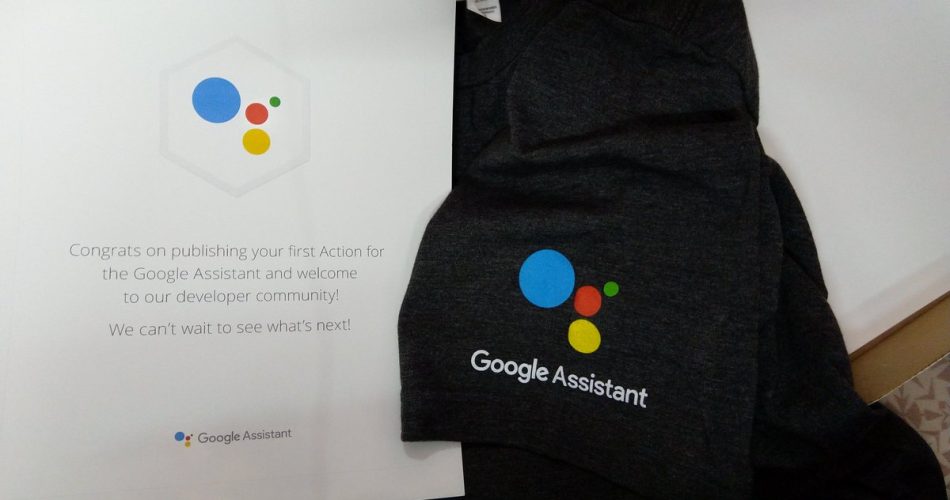Three years on from Google Assistant’s dispatch, Google has spread Assistant far and wide, all alone equipment, however through organizations with different organizations that sees Google Assistant in a wide scope of gadgets, from ice chests to earphones, speakers to vehicles
.Once the realm of pure science fiction, voice-based artificial intelligence is now a reality. Thanks to the help of A.I. like Alexa, Siri, and the Google Assistant, we’re now at the point where it’s entirely possible to listen to the news, see the day’s weather, send a text message, and start watching a video about the best way to fold your socks without looking up from your morning cereal or touching a device. If you’re an Android user, none is more integrated than the Google Assistant. It’s in your phone, it can be in your living room, and it’s ready to help you on the road.

Google’s artificial intelligence is as helpful or subtle as you want. But it hasn’t always been this way. Artificial intelligence has gone from fantasy to an integral part of our lives in just a few short years — and in the case of Google Assistant, it has sidled into our homes and lives without doing as much as disturbing the drapes. Here’s the history of how Google’s artificial intelligence came to dominate the Android world.
Google Assistant And What Can It Do : A Real & Amazing Assistant 2022
In my test lab — I mean, living room — an Amazon Echo, Google Home and Apple HomePod sit side by side, and the voice AIs battle it out to run my home like genies in high-tech bottles. Here’s the shorthand I’ve learned: Alexa is for accessibility. Google Assistant is for brainpower. And Siri is for security.
Amazon’s aggressive expansion makes Alexa the one I recommend, and use, the most. Google’s Assistant is coming from behind, matching feature by feature — and Siri, the original voice assistant, feels held back by Apple’s focus on privacy and its software shortcomings. (Amazon CEO Jeff Bezos owns The Washington Post, but I review all tech with the same critical eye.)
Smart speakers are building the smart home that you never knew you needed. Inside the audio equipment, they’re home hub computers that work alongside smartphone apps to connect and control disparate devices and services. Now with a speaker and the right connected gizmo, you can walk into a room and turn on the lights without touching a button. Or control the TV without a remote. Amazon even sells an Alexa-operated microwave that cooks, tracks and reorders popcorn.
But home assistants can also be Trojan horses for a specific set of devices and services that favor one company over another.
My buddy Matt recently asked me to help him pick speakers and appliances for a big remodel. He loves the Google Assistant on his Android phone, so selecting his tribe should be easy, right? Hardly: He wanted to put Sonos speakers all around the house, but they take voice commands directly via Alexa. (Sonos says Google Assistant support is coming, though it’s been promising that for a year.)
Figuring out which connected doodads are compatible can be like solving a 10,000-piece puzzle. The best smart home gadgets (like Lutron Caseta and Philips Hue lights) work across all three tribes, but sometimes alliances and technical concerns make appliance makers take sides.
Each AI has its limitations. They’re not all equally skilled at understanding accents — Southerners are misunderstood more with Google and Midwesterners with Alexa. The price of ownership with some is letting a company surveil what goes on in your house. You can try, like me, to live with more than one, but you’re left with a patchwork that won’t win you any favors with family.Look back up the Google Assistant’s family tree and it’s clear Google’s A.I. owes a lot to at least two previous services. The first and oldest part of Google Assistant is Google Voice Search. Voice Search made its debut on Android smartphones and Chrome for desktop PCs way back in June 2011, and while its functionality was basic by today’s standards, being able to give your phone voice commands marked a serious change in the way we were starting to interact with technology.
What can Google Assistant do?
The “OK Google” or “Hey, Google” side covers voice commands, voice searching, and voice-activated device control, letting you do things like send messages, check appointments and so on on your Android device, just like Apple’s Siri on an iPhone or iPad, but reaching far beyond that, with a bot-centric AI experience, designed to give you conversational interactions.
Google Assistant will:
control your devices and your smart home
access information from your calendars and other personal information
find information online, from restaurant bookings to directions, weather and news
control your music
play content on your Chromecast or other compatible devices
run timers and reminders
make appointments and send messages
open apps on your phone
read your notifications to you
Real-time spoken translations
Continued Conversation means you don’t have to say “Hey Google” for follow-up requests. Instead, once you’ve started talking to Google, it listens for a response without needing a trigger phrase all the time. Google can also recognise voice profiles for different people, so it knows who is talking to it and can tailor the responses accordingly – something that other systems are also beginning to offer.You can also ask for multiple things at the same time. This, Google said, is rather difficult. In linguistics, it is called coordination reduction. Mastering requests like this is probably what will power Google Assistant ahead of rivals.Because Google Assistant knows you and understands context, it can react in an informed or smart way. That’s important as Assistant spreads its wings, because it gives voice control a lot more power and moves it on from only reacting to specific phrases or commands. In the future, Google even says that Assistant will be able to call and book appointments for you. It’s designed to be more than just reactive.

Other cool features include the ability to check in to your flight (starting first with domestic flights with United Airlines), as well as the ability to book a room with partners like Choice Hotels, AccorHotels, InterContinental Hotels Group, Priceline, Expedia, Mirai, and Travelclick. Google is also adding adding support for Google Keep, Any.do, Bring!, and Todoist, so you can check your notes and lists with Google Assistant.We especially like the new Interpreter Mode, which began rolling out in early 2019 to Google Home devices and Smart Displays. With it, you can ask Google Assistant to help you conduct a conversation in dozens of languages. Just say “Hey Google, be my Spanish interpreter” to start Interpreter Mode and get real time spoken and (on Smart Displays) written translation to aid the conversation.Google Assistant in Google Home devices forms the foundation of smart home control. It’s compatible with a wide range of devices, so you can control heating, lights, and a lots more with your voice.
But Google Now was the real seismic shift in artificial intelligence. Built on Google Voice Search, development of Google Now was code-named “Majel” — after Majel Barrett, wife of Star Trek creator Gene Roddenberry and voice of the computer in many Star Trek series. While also an Easter egg, the code name was clearly a statement of Google’s intent — a dedication to achieving Star Trek‘s utopian future-tech.While Google Now wasn’t exactly an all-seeing or all-knowing computer, it formed the skeleton of the Google’s Assistant’s highly personalized feed. First introduced in Android 4.1 Jelly Bean, Google Now delivered your schedule, weather, and other useful information in a series of cards and notifications, letting you know if you needed to leave early for an appointment in order to avoid traffic, or telling you about nearby restaurants. Later updates brought in Gmail integration, and it was even smuggled onto iOS devices as a part of the iOS Google Search app.
Like Voice Search, you could ask Google Now questions — but unlike its predecessor, you would get responses spoken out loud, marking an important step toward a true A.I. experience. While useful, Google Now’s ability to converse was extremely limited, and it wasn’t capable of the sort of intricate conversations Google Assistant is now known for.
Most importantly, Google Now also introduced an iconic phrase that would become one of the keystones of the Google Assistant experience — the “OK Google” hotword.

Google Now was a revolution in how we interacted with our phones — but Google Assistant was a snapshot of the future.
Despite that grandiose statement, Google’s Assistant began life as a humble extra on Google’s Allo chat app. Its first job was to pop up during chats when useful, or when invited. It wasn’t perfect — and Google was still clearly keeping it at arm’s length from the rest of its services — but it was just the beginning. Google Assistant’s development was being treated differently from anything before it — as evidenced by Google’s hiring of Google Doodle head Ryan Germick and ex-Pixar animator Emma Coats to give the Assistant more personality.But it wasn’t long before Google Assistant broke free of its chains, coming first as a stand-alone feature to the original Google Pixel and the Google Home, before also arriving on other smartphones running Android 6.0 Marshmallow and above in 2017. This implementation of Assistant is probably the first time we saw the modern Assistant, with an interface that could be called up with the Home button and the ability to reply in a more conversational manner.
Though the initial version featured some gulfs between capabilities on mobile and Home speakers, Google reduced that gap as the months went by and quickly added Assistant functionality to its other products. Last year also saw Google announce its intention to add its Assistant to Android TV.So what lies ahead for the Google Assistant? Based on everything that’s come before, Google is nowhere near done with developing new features, and it’s highly likely it never will be. Will we look back at where we are now the same way we now look at the primitive nature of Google Now?
Google’s latest major addition to the Assistant is Duplex — a feature that allows the Assistant to call businesses and book appointments on your behalf. It responds to questions and alterations in real time, and uses filler words like “um-hm”. It was so convincing that some people worried it could be used to dupe real people. Thankfully, Google assured us that disclosure is built into the software.Use Up/Down Arrow keys to increase or decrease volume.
But Duplex is just the start of a new era for Google Assistant, and with Google’s software having gone from voice search to calling businesses in just seven years, imagine what A.I. will look like in 20. Scary? A little. But we’re also excited to see Star Trek’s “Majel” introduced into every aspect of our lives.







































